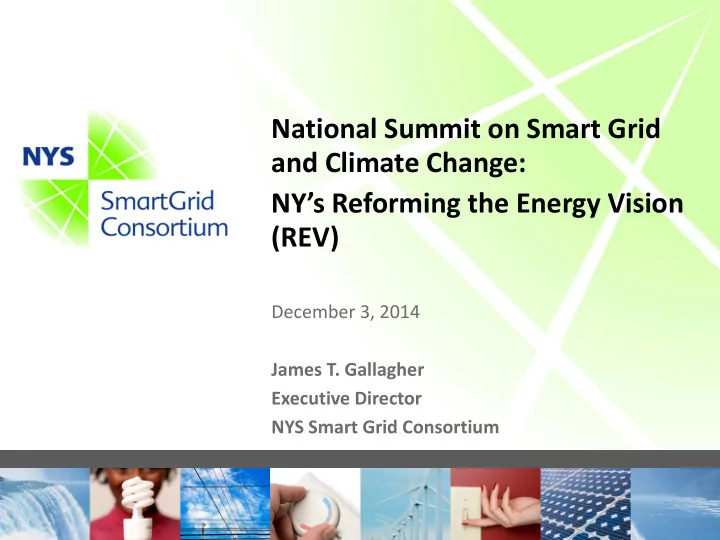

National Summit on Smart Grid and Climate Change: NY’s Reforming the Energy Vision (REV) December 3, 2014 James T. Gallagher Executive Director NYS Smart Grid Consortium
Consortium Overview 2
Consortium Mission Ongoing advocacy of Smart Grid / grid modernization Maintain vision of future grid Advocate benefits for producers, suppliers, and consumers of power Support initiatives that demonstrate capabilities of the smart grid Educate public, regulators, and policy makers Priorities for 2014/2015 Real world projects - - Multiple microgrid demonstrations Utility of the Future (REV) Strengthen research and international collaboration 3
Drivers of Change in NY Aging utility infrastructure, massive investment requirements Increasingly devastating storms and less tolerance of outages Changing consumer expectations and demands, especially for innovative third party services and understanding their energy use and bills Movement towards less centralized power system Integration of distributed resources on distribution networks Greater visibility into and automatic control of distribution networks Physical and Cyber Security 4
Drivers of Change (cont’d) Consumer technologies increasingly grid connected Rapidly increasing interest in Microgrids Recognition that regulated utility business models need added flexibility to encourage new technologies and innovative services Change in State Leadership on Energy Issues Growing impatience for change 5
NY’s Reforming the Energy Vision (REV) Proceeding Considering Fundamental changes in ways utilities provide distribution service Aligning electric utility practices and regulation with technological advances in information management, pricing, power generation and distribution Improving system efficiency, empowering customer choice, and encouraging greater penetration of clean generation and energy efficient technologies and practices 6
The Distribution System Platform An intelligent network platform that will provide safe, reliable and efficient electric services by integrating diverse resources to meet customers’ and society’s evolving needs. Key Functions of the DSP Designs and operates distribution system that integrates DERs as primary means of meeting system needs Plan for and accommodate new distributed generation and demand response Balance production and load in real time Monetize system & social values Coordinate interactions among customers, the distribution system and energy services companies (DSP markets and NYISO) Source: Rocky Mountain Institute 7
REV – Process Two Tracks Proceeding in Parallel Track 1 – Distribution System Platform (DSP) Model Consider changes necessary for DSPs to actively manage and coordinate distributed energy resources (DER), and provide vibrant market for third party energy services July 22, 2014 PSC Staff Straw Proposal NYS Smart Grid Consortium proposes to develop collaborative process on DSP business and technical architecture Jan: Track 1 Order Expected 8
REV – Process (cont’d) Track 2: Regulatory and Ratemaking Reforms To accommodate DSP business model that promote energy efficiency, renewable energy, least cost energy supply, fuel diversity, system adequacy and reliability, demand elasticity, and customer empowerment Jan 31: Track 2 Straw Proposal to be Released Early 2015: On-going market rules and technology platform design processes established and launched April/May: Track 2 Order Expected 9
Highlights on the REV Straw Proposal Coordination of DER via markets operated through a DSP is achievable and will benefit consumers Customers and vendors should have access to system information, to make transparent and readily available the economic value of time and location-variable usage Technology to support the DSP function is already available DSP function should initially be served by existing utilities, subject to performance reviews Stakeholder process needed for market design, Business and Technical architecture and standards and protocols 10
DPS Business & Technical Architecture – Consortium Proposed Process Market Design & Business Architecture Functions and capabilities required to establish competitive distribution markets, and carry out DSP role, including: Interactions with Dist. Energy Resource Providers Transaction management and settlement functions Financial management and billing Market information and participant interfaces Market rules and procedures Meter data management 11
DSP Business &Technical Architecture – (cont’d) Functional and Technical Architecture Functional Architecture . Identify interactions among market participants: Flow of information, energy and dollars Identify interfaces needing Standards & Protocols Technical/Application Architecture. Technologies and applications to support business capabilities. Adopt appropriate communications systems to ensure interoperability Complete assessment of technology availability and mapping policy to technology 12
New York Grid Transformation PSC staff identified “near-term, no regrets” actions to be immediately implemented” by utilities. What portion of NYS’s $30 billion in planned transmission and distribution system upgrades over next decade might be deferred? e.g. Con Ed seeking to invest in customer load management and grid upgrades to defer $1 billion in substation investment. Central Hudson Gas & Electric filed a $46 million plan with the PSC that includes community solar, demand response and a “Microgrid as a Service” program. 13
Microgrids: Microcosm of Future Utility Demonstrate New technologies - both demand and supply side New utility business and regulatory models New planning approaches How customers and communities can become engaged Showcase potential end states Expose issues and barriers that need to be addressed 14
TOMORROW’S CITY TODAY The Related Company
Contact Information New York State Smart Grid Consortium 387 Park Avenue South 3rd Floor New York, NY 10016 James T. Gallagher, Executive Director jgallagher@nyssmartgrid.com 18
Recommend
More recommend